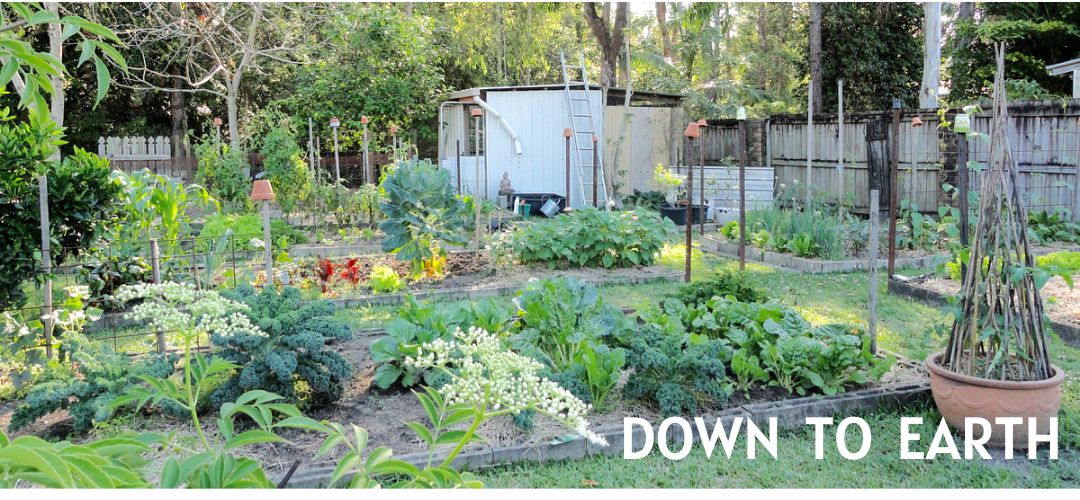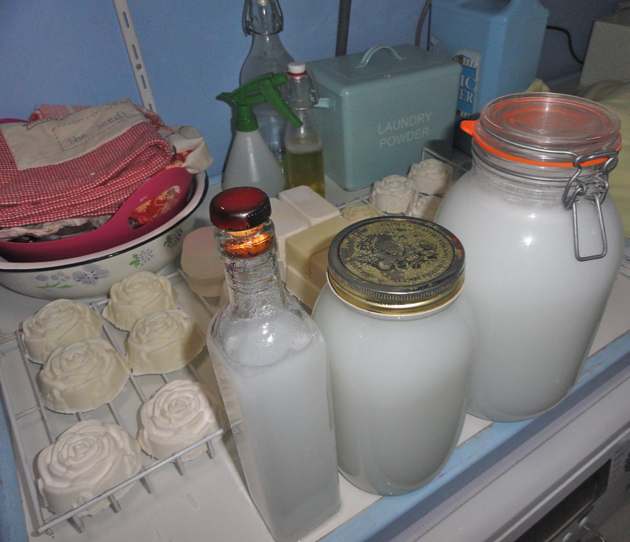I watched a BBC documentary on UTube while I was ironing yesterday. It showed a Hutterite community, living on the Canadian prairies, who had voluntarily cut themselves off from the rest of the world. The entire program was interesting but what I liked most was how this small community banded together and as a group of about 160 people in numerous large family groups, sustained themselves and earned a living. They had dairy cows and a chicken farm and the community provided the workforce for the cows to be milked every day and to get the chickens to eggs and meat. There was no outside help. It is their way for the women to work in the home while caring for the family, the children went to primary school and the rest of the people there all had a job working for the collective good of the group. Unfortunately I can't say everyone was happy but they were all productive.
Making your own soap and laundry products will give you good quality cleaning products with far fewer chemicals, while reducing the cost of living.
Growing calendulas and other flowers and herbs allows you to add beneficial extras to your soap and cleaners without added cost.
You can make good bread for less than you buy it for.
As most of you know, I'm old enough to have been in my in my teens and 20s during the sixties. Many hippies went back to the land then and while most of them lived in poverty, some thrived. Then in the 1970s, during the world-wide oil crisis, people from all walks of life tried to make good lives working their own land.
Now in 2015 it is still possible, through hard work, organisation and planning, to work your own land so that it sustains you. There are a number of people who read this blog who do exactly that. Usually they have paid off a mortgage or are close to it, and they give up a full time job and use that time to work the land instead. They still need to earn some money though. Often one part of a couple will go out to part-time work. Or they both work part-time and have the equivalent of a full-time wage. That cash money goes towards bills for phone, electricity, clothing, shoes, health, transport and possibly travel and entertainment.
You'll need to develop the skills to help you store an abundance of food when certain things are in season. Knowing how to preserve/can food will give you seasonal food in the form of jams, sauces and relish even out of season. It will also give you a variety of food all through the year without having to go to the supermarket to get it.
If you have a house cow or goats, you can make a wide variety of dairy foods, including butter to spread on your bread.
Saving the seeds of open pollinated vegetables provides heirloom vegetables and fruit without having to buy new seeds every year.
Pure breed chickens, with the addition of a rooster, will give you a continuous supply of chickens for eggs and meat.
John Seymour wrote an excellent book The New Complete Book Of Self Sufficiency * (UK) that gives details of backyards, one acre and five acre plots and how you can best manage them. And Carla Emery (USA) has her widely read book The Encyclopaedia of Country Living *. Sadly, both these authors are dead now, but I have had both these books for many years and I am happy to recommend them to you. There are two Australian books I can recommend too - The Permaculture Home Garden by Linda Woodrow and Backyard Self Sufficiency by Jackie French. Three of these books guided me early on. All the authors lived this life for many years and built their skills by doing what they write about. They share good ideas on how to do things most books don't even mention. *If you're in Australia, all these books are available locally from Booktopia.
These photos of our vegetable garden are from a few years ago when we grew as much as we could. This gave us the opportunity to freeze and preserve the excess for later in the year.
I guess Hanno and I lived off our land too for the past thirteen years before we started to pull back a bit because of our age. Now we are content to tend smaller gardens. If you have the land and are debt-free, and if you have the energy and will to do it, partial self-sufficiency in a backyard garden is entirely possible. If you start out with the intention of growing all or most of your fruit and vegetables, and you keep chickens or have aquaponics fish, it will take about a year to be in full production but you'll have a good chance of success. If you're vegetarian, it will be quicker. Add bees and a goat or a house cow if you have enough land, you'll also have honey and milk and you'll be able to make cheese, butter yoghurt and soap with the excess. If you're in the sub-tropics or tropics, you could even grow your own coffee, tea and nuts - it's all there for the taking as long as you put in the work. And it's hard rewarding work. You need to know what you're doing or have a mentor close at hand, but it is possible. If you can't grow everything you need, grow as much as you can and buy in the small amount that you can't produce.
There are other things you can do, along with food production, to help reduce the cost of living. Recycling, repairing, mending, solar panels, making your own fertilisers and saving water from the roof will all fit well into your backyard scheme. In fact, if you're going to grow a large garden, setting up a water catchment system from the roof to tanks or several water buts will save money on water and help fulfil your ideal of sustainability. Whatever you can do to recycle and repair and save precious resources - be they financial or produce, will stand you in good stead as the years progress. Foraging and bartering help too and they're both a vibrant part of many sustainable communities. It all takes careful planning though and you have to learn all the skills you need. You can't just stumble along because if a crop fails, you'll be without that particular food for that season or you'll have to return to the shops to buy it.
This is the second water tank we put in and it sits behind our shed. It collects water from the shed roof and part of the house roof. Using this plastic tank and the metal one below, we can store 15,000 litres of water and we never have to use town water on the garden or for anything outside.
This white down pipe on the side of the house runs under the pathway and over to the large tank photographed above. Hanno rigged this system of collection pipes so we could collect water from the house room and store it in the large tank attached to our shed.
This is the original tank we put in during our first year here. It's still the tank I use to water the vegetable garden and bush house.
Pay off your debt, or get close to it, before you start. Living with no monthly mortgage payments will make the path ahead so much easier. Make a plan - work out what fresh produce you eat every week and every season then find out how much of that you can grow yourself. Work out the cost as well because there is no benefit in growing food if you're paying so much for water that you'd be better off buying what you need. If you live near someone who is already doing this, I'm pretty sure they'll help you learn the skills you need and give you ideas about how to organise yourself. If you don't have anyone and want to dive in, go over to the forum and share your story there. There is a lot of information about building soil fertility, saving seeds, growing various crops, preserving, storage etc. already there and I've just created a thread where this important topic can be discussed over the coming days. If you're not already a member, you can join free of cost. I'll be popping into the thread when I have time and I'll help as much as I can but there are also a lot of other people there who will be willing to help.













